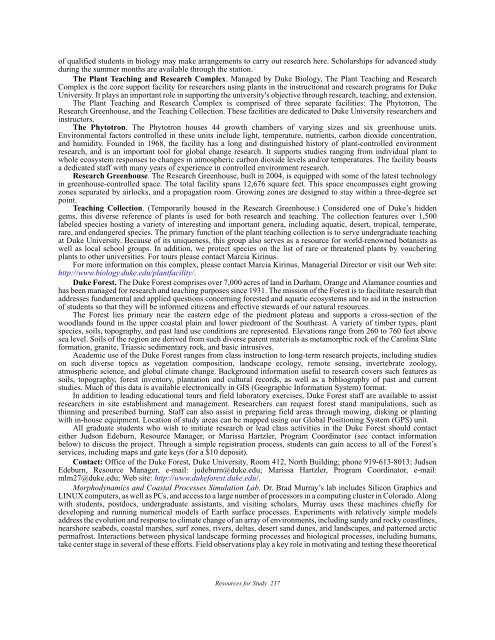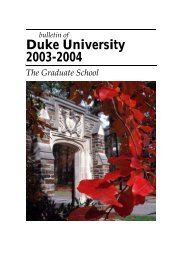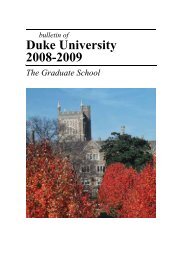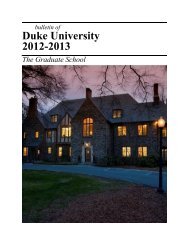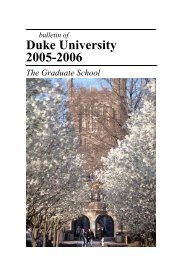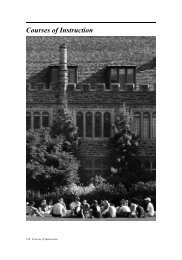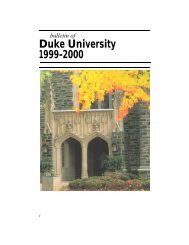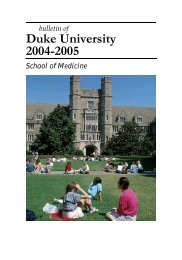Duke University 2009-2010 - Office of the Registrar - Duke University
Duke University 2009-2010 - Office of the Registrar - Duke University
Duke University 2009-2010 - Office of the Registrar - Duke University
You also want an ePaper? Increase the reach of your titles
YUMPU automatically turns print PDFs into web optimized ePapers that Google loves.
<strong>of</strong> qualified students in biology may make arrangements to carry out research here. Scholarships for advanced study<br />
during <strong>the</strong> summer months are available through <strong>the</strong> station.<br />
The Plant Teaching and Research Complex. Managed by <strong>Duke</strong> Biology, The Plant Teaching and Research<br />
Complex is <strong>the</strong> core support facility for researchers using plants in <strong>the</strong> instructional and research programs for <strong>Duke</strong><br />
<strong>University</strong>. It plays an important role in supporting <strong>the</strong> university's objective through research, teaching, and extension.<br />
The Plant Teaching and Research Complex is comprised <strong>of</strong> three separate facilities: The Phytotron, The<br />
Research Greenhouse, and <strong>the</strong> Teaching Collection. These facilities are dedicated to <strong>Duke</strong> <strong>University</strong> researchers and<br />
instructors.<br />
The Phytotron. The Phytotron houses 44 growth chambers <strong>of</strong> varying sizes and six greenhouse units.<br />
Environmental factors controlled in <strong>the</strong>se units include light, temperature, nutrients, carbon dioxide concentration,<br />
and humidity. Founded in 1968, <strong>the</strong> facility has a long and distinguished history <strong>of</strong> plant-controlled environment<br />
research, and is an important tool for global change research. It supports studies ranging from individual plant to<br />
whole ecosystem responses to changes in atmospheric carbon dioxide levels and/or temperatures. The facility boasts<br />
a dedicated staff with many years <strong>of</strong> experience in controlled environment research.<br />
Research Greenhouse. The Research Greenhouse, built in 2004, is equipped with some <strong>of</strong> <strong>the</strong> latest technology<br />
in greenhouse-controlled space. The total facility spans 12,676 square feet. This space encompasses eight growing<br />
zones separated by airlocks, and a propagation room. Growing zones are designed to stay within a three-degree set<br />
point.<br />
Teaching Collection. (Temporarily housed in <strong>the</strong> Research Greenhouse.) Considered one <strong>of</strong> <strong>Duke</strong>’s hidden<br />
gems, this diverse reference <strong>of</strong> plants is used for both research and teaching. The collection features over 1,500<br />
labeled species hosting a variety <strong>of</strong> interesting and important genera, including aquatic, desert, tropical, temperate,<br />
rare, and endangered species. The primary function <strong>of</strong> <strong>the</strong> plant teaching collection is to serve undergraduate teaching<br />
at <strong>Duke</strong> <strong>University</strong>. Because <strong>of</strong> its uniqueness, this group also serves as a resource for world-renowned botanists as<br />
well as local school groups. In addition, we protect species on <strong>the</strong> list <strong>of</strong> rare or threatened plants by vouchering<br />
plants to o<strong>the</strong>r universities. For tours please contact Marcia Kirinus.<br />
For more information on this complex, please contact Marcia Kirinus, Managerial Director or visit our Web site:<br />
http://www.biology.duke.edu/plantfacility/.<br />
<strong>Duke</strong> Forest. The <strong>Duke</strong> Forest comprises over 7,000 acres <strong>of</strong> land in Durham, Orange and Alamance counties and<br />
has been managed for research and teaching purposes since 1931. The mission <strong>of</strong> <strong>the</strong> Forest is to facilitate research that<br />
addresses fundamental and applied questions concerning forested and aquatic ecosystems and to aid in <strong>the</strong> instruction<br />
<strong>of</strong> students so that <strong>the</strong>y will be informed citizens and effective stewards <strong>of</strong> our natural resources.<br />
The Forest lies primary near <strong>the</strong> eastern edge <strong>of</strong> <strong>the</strong> piedmont plateau and supports a cross-section <strong>of</strong> <strong>the</strong><br />
woodlands found in <strong>the</strong> upper coastal plain and lower piedmont <strong>of</strong> <strong>the</strong> Sou<strong>the</strong>ast. A variety <strong>of</strong> timber types, plant<br />
species, soils, topography, and past land use conditions are represented. Elevations range from 260 to 760 feet above<br />
sea level. Soils <strong>of</strong> <strong>the</strong> region are derived from such diverse parent materials as metamorphic rock <strong>of</strong> <strong>the</strong> Carolina Slate<br />
formation, granite, Triassic sedimentary rock, and basic intrusives.<br />
Academic use <strong>of</strong> <strong>the</strong> <strong>Duke</strong> Forest ranges from class instruction to long-term research projects, including studies<br />
on such diverse topics as vegetation composition, landscape ecology, remote sensing, invertebrate zoology,<br />
atmospheric science, and global climate change. Background information useful to research covers such features as<br />
soils, topography, forest inventory, plantation and cultural records, as well as a bibliography <strong>of</strong> past and current<br />
studies. Much <strong>of</strong> this data is available electronically in GIS (Geographic Information System) format.<br />
In addition to leading educational tours and field laboratory exercises, <strong>Duke</strong> Forest staff are available to assist<br />
researchers in site establishment and management. Researchers can request forest stand manipulations, such as<br />
thinning and prescribed burning. Staff can also assist in preparing field areas through mowing, disking or planting<br />
with in-house equipment. Location <strong>of</strong> study areas can be mapped using our Global Positioning System (GPS) unit.<br />
All graduate students who wish to initiate research or lead class activities in <strong>the</strong> <strong>Duke</strong> Forest should contact<br />
ei<strong>the</strong>r Judson Edeburn, Resource Manager, or Marissa Hartzler, Program Coordinator (see contact information<br />
below) to discuss <strong>the</strong> project. Through a simple registration process, students can gain access to all <strong>of</strong> <strong>the</strong> Forest’s<br />
services, including maps and gate keys (for a $10 deposit).<br />
Contact: <strong>Office</strong> <strong>of</strong> <strong>the</strong> <strong>Duke</strong> Forest, <strong>Duke</strong> <strong>University</strong>, Room 412, North Building; phone 919-613-8013; Judson<br />
Edeburn, Resource Manager, e-mail: judeburn@duke.edu; Marissa Hartzler, Program Coordinator, e-mail:<br />
mlm27@duke.edu; Web site: http://www.dukeforest.duke.edu/.<br />
Morphodynamics and Coastal Processes Simulation Lab. Dr. Brad Murray’s lab includes Silicon Graphics and<br />
LINUX computers, as well as PCs, and access to a large number <strong>of</strong> processors in a computing cluster in Colorado. Along<br />
with students, postdocs, undergraduate assistants, and visiting scholars, Murray uses <strong>the</strong>se machines chiefly for<br />
developing and running numerical models <strong>of</strong> Earth surface processes. Experiments with relatively simple models<br />
address <strong>the</strong> evolution and response to climate change <strong>of</strong> an array <strong>of</strong> environments, including sandy and rocky coastlines,<br />
nearshore seabeds, coastal marshes, surf zones, rivers, deltas, desert sand dunes, arid landscapes, and patterned arctic<br />
permafrost. Interactions between physical landscape forming processes and biological processes, including humans,<br />
take center stage in several <strong>of</strong> <strong>the</strong>se efforts. Field observations play a key role in motivating and testing <strong>the</strong>se <strong>the</strong>oretical<br />
Resources for Study 237


